by Editor | Jul 25, 2011 | Accomodations, Ecotourism
Article and photos by Josette King
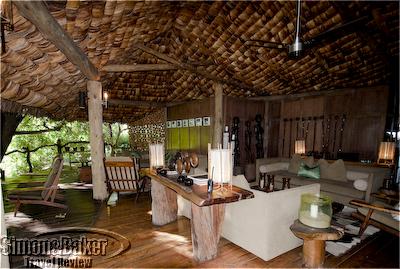
The main lodge at Lake Manyara opens onto a deck
Having enjoyed memorable safari experiences at &Beyond lodges and camps during a previous visit to Southern Africa, I was delighted to include three of their properties in my recent itinerary around Tanzania. All three were located in the Northern Circuit of the country, in the legendary destinations of the Serengeti, Ngorongoro Crater and Lake Manyara. And all three delivered superb guiding, outstanding comfort and attentive service. But then, that is considered de rigueur from any reputable luxury safari organization. So, I asked myself, what is the magic ingredient that makes the &Beyond properties I have stayed at stand out in my mind? There are two actually:
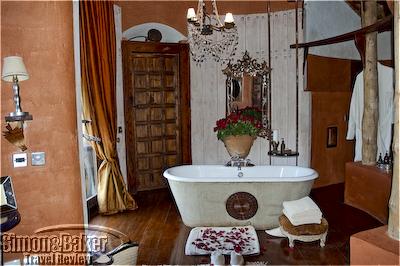
A welcome rose petal bath at Ngorongoro Crater
First, there is Chris Browne, &Beyond’s creative director, the versatile wizard who conjures up for each property an unpredictable and sometimes improbable environment fully integrated within its distinctive surroundings. Each location was a new aesthetic surprise for me with its unique personality but always merely a setting for uncompromising comfort.
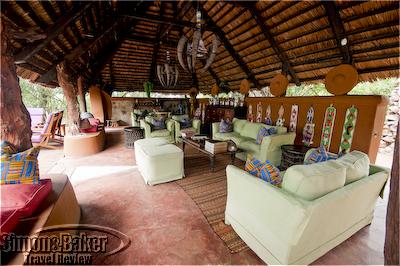
The lounge at Serengeti Grumeti Tented Camp
My first stop of the Northern Circuit was Serengeti Grumeti Tented Camp, in the far northern reaches of the Serengeti National Park. Although just a short drive from the pale grasslands and stark vistas of the “endless plain,” the camp was nestled along the verdant bank of the Grumeti River. To further play on this contrast the décor was an explosion of colors and entertaining details. The lime green sofas of the lounge had vibrant blue and orange pillows that contrasted further with the bright purple market umbrellas and seat cushions of the deck furniture. Whimsical interpretations put a new spin on traditional arts, with light fixtures of fine Masai beadwork and witty polychrome woodcarvings of men in costumes of the colonial era standing guard in a corner of the lounge. It was impossible not to be in a playful mood at this camp.
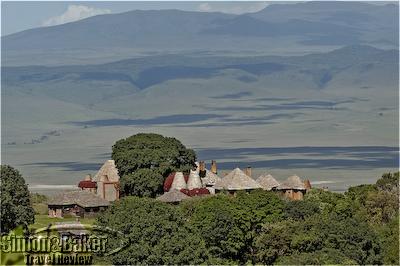
The lodge is perched at the very rim of the Ngorongoro Crater
My next destination was the Ngorongoro Crater Lodge. There, in a fairytale mud and brick village balanced on the very rim of the largest intact caldera on the planet, a Victorian extravaganza awaited, its tongue-in-cheek glamour a perfect foil for the breathtaking scenery below. In generous spaces where rich Zanzibar paneling alternated with whitewashed plaster, miles of raw silk draped soaring French windows, antique mirrors reflected crystal chandeliers, and overstuffed cut velvet sofas were piled with jewel-toned pillows. On 19th century guéridons, urns filled with long-stem roses alternated with fine bronzes of big game and flowing art-nouveau statuettes. Even my bathroom had its own chandelier and Persian carpet!
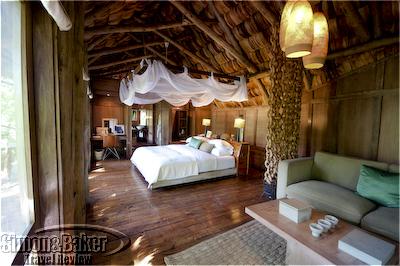
My room at Lake Manyara
The last stop of my journey was Lake Manyara Tree Lodge, a serene retreat tucked in a dense forest of ancient mahoganies, in the foothills of the Rift Valley escarpment, a mere 10 minute drive from the lake shore. Here minimalist luxury prevailed, with clean-lined contemporary furniture and neutral tones. Public areas opened onto a large circular boma (fenced enclosure) with its own brick oven barbecue and central campfire for romantic fireside dinners under the stars. My suite was a genuine tree house, set on a platform perched on stilts high in the boughs of the forest. Screened-in outer partitions opened onto a large veranda that seemed to melt into the forest beyond. I enjoyed eye-level contact with the rich bird-life and the occasional overhead visit of the rarely seen blue monkeys. I couldn’t have wished for a more inspiring environment to bid goodbye to Africa, and relax before the long journey home.
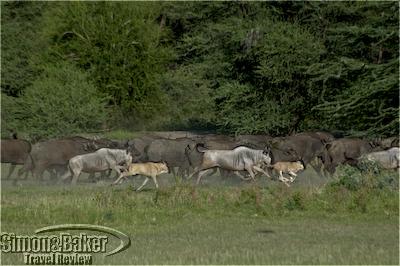
A herd of wildebeests rushes past at Lake Manyara
The second ingredient in the &Beyond magic comes from its multi-level involvement in the local community. Managers told me of priority local hiring of their staff, cross-functional training and internal promotion practices. Young butlers eager to show off their language skills spoke to me of the company-sponsored English lessons; some confided their aspirations to become rangers, and pointed to guides that had started as household staff. At Serengeti Grumeti camp, I had the pleasure to congratulate May Kobero, who after several years in increasing levels of administrative positions, had been officially promoted to the camp’s top job that very morning. I was heartened to find several women in managerial and professional positions (including two women guides at the Crater Lodge). This in turn fosters an enthusiasm and pride in being “&Beyonders” as the staff likes to call themselves that is directly reflected in the quality of service I enjoyed during my stay.
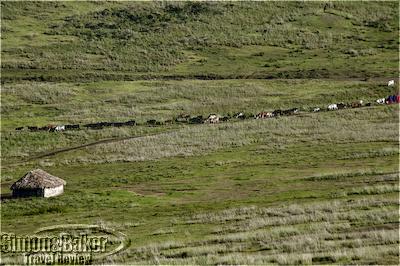
Masai shepherds guide their cattle down the outer edge of the Ngorongoro Crater
Then there is the grass-root level involvement in the community at large: fresh produce purchased from local growers who practice chemical-free farming (from seeds donated by &Beyond), honey from local hives, and the work of local craftspeople integral in the décor of the camps and sold at the camp boutiques. And most importantly, through the &Beyond Foundation, there is the extensive effort to promote literacy in local children. Each property sponsored a school (two of which I had the pleasure to visit) that serves surrounding villages and educates around 600 children. Efforts can range from providing the most basic necessities such as windows, desks and sanitary facilities as well as school supplies, to starting a kindergarten where Masai children can learn Swahili before they enter primary school.
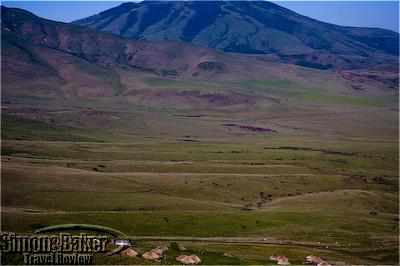
Masai village near the Ngorongoro Crater
There is a special focus on promoting school attendance for girls. Additionally there is an extensive effort on the part of the guides who volunteer their time to educate children on conservation and game protection issues. During the low season they also arrange game drives for the best performing pupils (competition is intense!). And &Beyond encourages Masai adolescents to preserve their cultural heritage. Twice per week during the year a large group of high-school children are bussed from surrounding villages to the Ngorongoro Crater Lodge where they perform their traditional dances and songs for the guests. This is a much sought-after opportunity, as in addition to earning a stipend for their performance, there is an ancillary perk. I noticed a discrete undertone of boys and girls from different villages “checking each other out” throughout the evening.
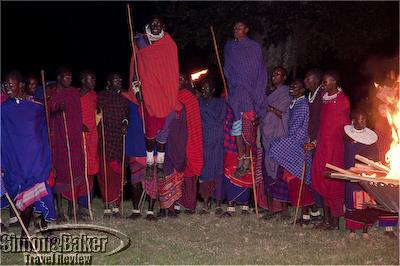
Masai students demonstrate their jumping skills for Crater Lodge guests
It is this multi-faceted combination of aesthetic enjoyment drawn from the luxurious and witty environments created by Chris Browne coupled with the pride and enthusiasm of the staff, as reflected in the superb quality of service, that has made my stay at these properties consistently memorable. As for the for community involvement of &Beyond, it addresses my ever present concern about the impact of luxury tourism on local populations. It enables me to better enjoy the superb accommodations and hospitality of the properties, knowing that my visit contributes, however modestly, to providing growth opportunities to the local population while helping preserve their culture and natural environment.
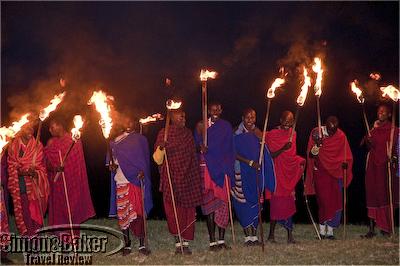
Masai students share their traditional dances with Crater Lodge guests
Visit the Simon & Baker Travel Review to read more about my visit to Tanzania, Serengeti Grumeti Tented Camp, Ngorongoro Crater Lodge and Lake Manyara Tree Lodge.
by Editor | Jul 18, 2011 | Attractions
Article and photos by Joachim Castellano
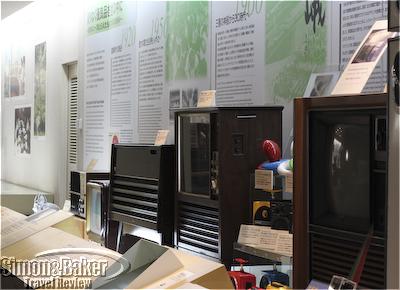
Early Panasonic radios and tape players
The Konosuke Matsushita Museum, established 1968, is a small one-story exhibition space located on the campus of the global giant electronics company, Panasonic. The museum, located about 20 kilometers from Osaka, tells the story of the stratospheric rise of Panasonic’s founder Konsuke Matsushita to one of the world’s most successful industrialists. Inside a cozy building modeled after the original 1933 Panasonic head office many first generation consumer electronics are on display, from TVs to washing machines.
It was fascinating to see the initial models, whose design genius us modern folk have come to ignore like windows and doorknobs. Panasonic’s first radio, made of beautiful wood with a distinctive octagonal speaker, was likely met with the same jaw-dropping awe awarded to today’s smartphones and tablet computers. To the digital generation, these gadgets might appear as ancient as Egyptian artifacts. However, digital DJ’s should pay respects and bow at the altar of the Technics Turntable record player, a key tool that set stage for art forms such as hip hop and dance music.
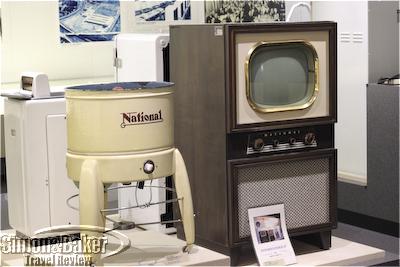
Early models of televisions and washing machines on display
The museum is not just a historical hit parade for Panasonic merchandise. I glimpsed into a time capsule of Japanese history after the devastation of World War II. On display are copies of Time and Life Magazine from the 1960s whose cover stories feature Japan. It was interesting to witness the American media coverage of Japan’s transformation as it was happening. The issue of Time on display features an interview with Matsushita, whose success story parallels Japan’s rise as an economic superpower.
Aspiring CEOs might also find golden nuggets of advice from Matsushita’s teachings on business. His process, I had the impression, created global hit products for decades. The basic business principles he developed are still practiced by Panasonic today. The future Bill Gates or Steve Jobs should not miss visiting this gem of a museum.
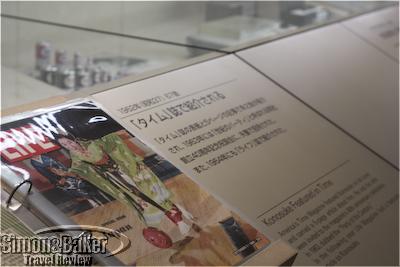
Early magazine articles from Time and Life were on display
Signage and information was available in Japanese and English. A few video and audio clips were in Japanese only. The museum, owned and managed by Panasonic Corporation, was a three minute walk from Nishi-sanso station on the Keihan Line.
The Konosuke Matsushita Museum might be small in size, but it is rich in Japanese and electronics history. It houses models of the world’s first VHS VCR along with information about post-war Japanese history and corporate management. Konosuke Matsushita Museum, 1006, Kadoma, Kadoma City, Osaka 571-8501, Japan, + 81 06-69 060 0106, fax: + 81 06 69 06 1894, http://panasonic.net/history/museum
by Editor | Jul 11, 2011 | Accomodations
Article and photos by Josette King
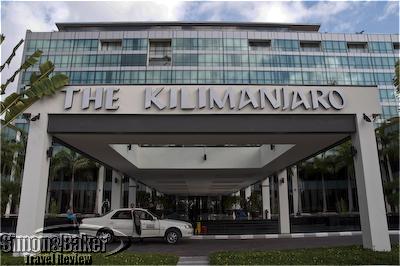
The facade of the Kilimanjaro Kempinski Hotel
It’s a long way from North America to Tanzania, and there is no easy way to get there. Although I had treated myself to a weekend stopover in Europe, the remaining leg of my journey had started with a pre-dawn wake-up call, then the long hours of pre-departure chaos inherent to large international airports. The flight seemed to go on forever, as did arrival formalities. It was past midnight by the time I shuffled into the poorly lit arrival hall at Dar es Salaam International Airport, travel-worn and circumspect. This was my first visit to Tanzania and all that I had heard of the city’s reputation for crime and petty theft dictated vigilance. Then a sign caught my eye, held by a smiling man. “Kili Kempinski,” the sign said, with my name neatly printed below. All was well!
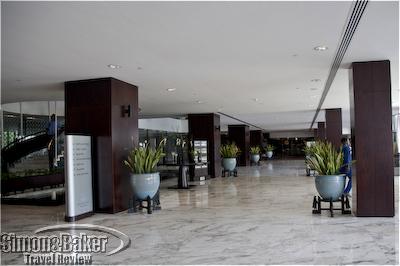
The foyer
Comfortably settled in the late model, air-conditioned car, a bottle of chilled water in hand, I watched the gloomy empty streets zoom by, thankful for the efficient staff of the Kilimanjaro Hotel Kempinski who had arranged my airport transfers. Soon, we were entering a gated garden and pulling under the deep canopy of the hotel entrance. I was welcomed by an awaiting doorman who ushered me to the reception desk. The Kili (as the hotel is affectionately known by its local patrons) clearly understands middle-of-the-night arrivals, and how to whisk guests to their bed in record time. I barely had a chance to catch in my peripheral vision the cool white marble foyer with its line of rosewood-clad pillars and large turquoise ceramic urns filled with greenery, before I was in the elevator to my room.
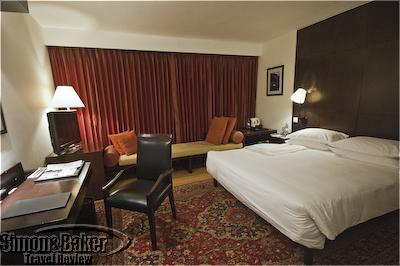
My room at the Kempinski
There, luxurious contemporary décor hinted at the promise of a serene night’s sleep. Subdued lighting filled the room with a warm glow revealing the king size bed, its silky high-count cotton bedding invitingly turned down. Crimson velvet drapes were cozily drawn across the long picture window. I hesitated briefly at the tempting sight of the deep freestanding tub in the center of the ultra-modern bathroom before stepping into the walk-in shower. My next recollection is of a wake-up call pulling me out of the embrace of my ultra-comfortable bed. I opened the drapes to a panoramic view of the harbor. Against a backdrop of modern infrastructure and large cargo ships, a lone dhow, its traditional triangular sail arching in the morning breeze, was slowly making its way across the water as dhows have for centuries. This was indeed the Indian Ocean, and the Kili the perfect place to catch my breath before starting off on my safari.
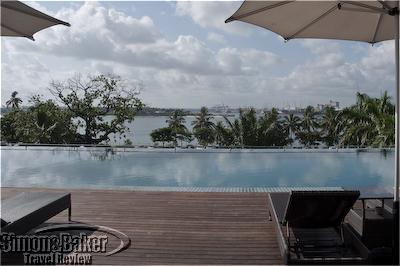
The pool area looks out over the harbor
Originally open in 1965 as the first contemporary luxury hotel in Dar es Salaam, the property had eventually fallen in disrepair before shutting its doors three decades later. After being shuttered for several years, it was acquired in 2004 by Ali Saeed Juma Albwardy, a United Arab Emirates industrialist who restored the landmark property to its earlier grandeur. Opened in 2005 under the under the management of Kempinski Hotels, it is once again a favorite of the business and political elite of the city. And a stopover of choice for weary travelers who enjoy the Kili’s personalized service and its appealing blend of European comforts and East African hospitality.

Breakfast in the Palm Restaurant
After a hearty breakfast cooked to order in the open kitchen of the sunny Palm Restaurant, it was time to step into the awaiting car and be driven back to the airport for my flight to Mikumi National Park. I had just enough time before I left to catch a glimpse of the long, shimmering infinity-edge swimming pool on its terrace raised above the harbor, and the serene foyer of the Anantara Spa. This reinforced my conviction that not only would the Kilimanjaro Hotel Kempinski (Kivukoni Street, P.O. Box 9574, Dar es Salaam, Tanzania, + 255 764 704 704, http://www.kempinski.com/en/daressalaam, reservations.tanzania@kempinski.com) be my home in Dar es Salaam whenever travel opportunities in East Africa bring me back to the city, but next time, I will plan a longer stop there. Visit the Simon & Baker Travel Review to read more about my visit to Tanzania.
by Editor | Jul 5, 2011 | Accomodations, Luxury Travel, Restaurants
Article and photos by Laura Scheiber

Lobby of The Ritz-Carlton, Powerscourt
During a springtime trip to Ireland, my travel partners and I stayed at The Ritz-Carlton, Powerscourt. Located on the grounds of the 1,000-acre Powerscourt Estate in County Wicklow, the resort was situated in a lush green countryside setting roughly 40 minutes outside of Dublin.
The lobby had a majestic feel with high ceilings and was tastefully decorated in deep wooden browns and gold, with vibrant fresh flowers. Following the check-in, the front desk receptionist escorted me to my Mountain View Suite (number 352). On the way she chatted with me in a friendly manner, suggesting a number of activities that I might enjoy.
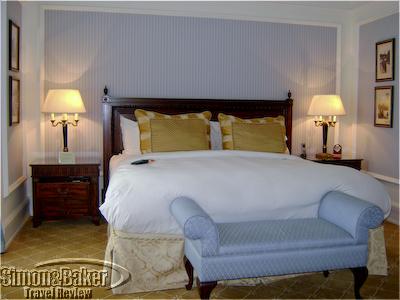
The bedroom in suite 352
Upon opening the door I was pleased by the elegant décor of the 700 square-foot suite. The entry hallway, which had a powder room on the right hand side, led to a Georgian style sitting room with an ornamental fireplace. Around the corner was a spacious area with a dining table and a large wooden desk. Farthest from the entrance was the bedroom opening out onto a terrace that provided a view of Sugar Loaf Mountain. Next to the bedroom and walk-in closet was a generous-sized bathroom with a separate bathtub, shower and toilet room.

Fresh scones upon arrival
Five minutes after I arrived, one of the staff members delivered freshly baked scones (still warm) with butter and jam. The suite had numerous modern details, including a touch screen system that controlled the lights, curtains and air conditioning, and televisions in the sitting area, bedroom and bathroom. Toiletries included: Gilchrist & Soames Bath Caviar (bath beads), facial spray and lip balm; Ritz-Carlton mouth wash and dental kit; and 1.3 ounce-sized Acqua Di Parma shampoo, conditioner, shower gel, soap, and lotion. Two plush terry robes hung on the bathroom wall next to the shower.
The color scheme of the suite was white, gold and light blue, while the bathroom had predominantly white-marble walls. The suite was immaculately clean. Throughout the evening I enjoyed a number of additional amenities including complimentary 24-hour hi speed wi-fi access, a complimentary box of eight gourmet chocolate truffles, and turn down service that included a bottle of mountain spring still water and relaxing pillow spray.
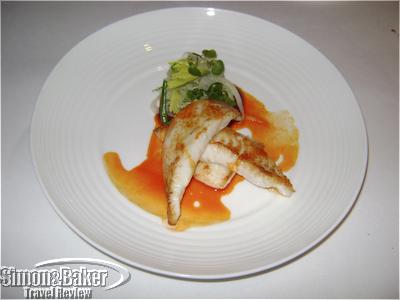
The John Dory fish in blood orange puree at Gordon Ramsay at Powerscourt
In the evening, I dined at the Gordon Ramsay at Powerscourt restaurant on the third floor of the hotel. Ceiling-to-floor glass windows offered stunning views of Sugar Loaf Mountain and added a spacious feel to the dining area. I enjoyed a six-course meal that began with a green pea puree, compliments of the chef, followed by a goat cheese and red beet salad. My main course was preceded by a delicious spring garlic puree. While I enjoyed a yummy spinach and mushroom gnocchi, my travel mates had rave reviews about their John Dory fish in a blood orange puree, fennel salad and chorizo emulsion, and the Donald Russell beef fillet with wild mushrooms, triple cooked chips, and pepper sauce. The meal was complete with a mouthwatering lemon curd on Brittany shortbread and crystallized raspberries.
We enjoyed complimentary gourmet mini chocolates and pastries at the chef’s table in the kitchen where we met Ludovic Lantier, the executive pastry chef. He explained what was in each of the mini-pastries and answered our questions in a friendly manner.

Ludovic Lantier, executive pastry chef
Throughout the meal, my wine glass was never empty thanks to the attentive wait staff. Both the Cerro Del Masso, a Chianti red wine, and the Las Colinas del Ebro, a Garnacha white wine from Spain, went well with the meal, but I preferred the white wine. The wait staff and manager were friendly and seemed genuinely committed to ensuring that we had an enjoyable dining experience.
Overall, my stay at The Ritz-Carlton, Powerscourt, (Powerscourt Estate, Enniskerry, Ireland, + 353 1 274 8888, http://www.ritzcarlton.com/en/Properties/Powerscourt/Default.htm, powerscourtreservations@ritzcarlton.com) was a pleasure. My spacious and luxurious suite with mountain views combined with the hotel’s elegant ambiance, friendly service, and gourmet dining lived up to my expectations of an evening at The Ritz-Carlton.






























